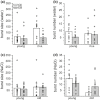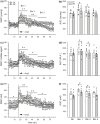The anti-dipsogenic and anti-natriorexigenic effects of estradiol, but not the anti-pressor effect, are lost in aged female rats
- PMID: 34288542
- PMCID: PMC8290476
- DOI: 10.14814/phy2.14948
The anti-dipsogenic and anti-natriorexigenic effects of estradiol, but not the anti-pressor effect, are lost in aged female rats
Abstract
Estradiol (E2) inhibits fluid intake in several species, which may help to defend fluid homeostasis by preventing excessive extracellular fluid volume. Although this phenomenon is well established using the rat model, it has only been studied directly in young adults. Because aging influences the neuronal sensitivity to E2 and the fluid intake effects of E2 are mediated in the brain, we tested the hypothesis that aging influences the fluid intake effects of E2 in female rats. To do so, we examined water and NaCl intake in addition to the pressor effect after central angiotensin II treatment in young (3-4 months), middle-aged (10-12 months), and old (16-18 months) ovariectomized rats treated with estradiol benzoate (EB). As expected, EB treatment reduced water and NaCl intake in young rats. EB treatment, however, did not reduce water intake in old rats, nor did it reduce NaCl intake in middle-aged or old rats. The ability of EB to reduce blood pressure was, in contrast, observed in all three age groups. Next, we also measured the gene expression of estrogen receptors (ERs) and the angiotensin type 1 receptor (AT1R) in the areas of the brain that control fluid balance. ERβ, G protein estrogen receptor (GPER), and AT1R were reduced in the paraventricular nucleus of the hypothalamus in middle-aged and old rats, compared to young rats. These results suggest the estrogenic control of fluid intake is modified by age. Older animals lost the fluid intake effects of E2, which correlated with decreased ER and AT1R expression in the hypothalamus.
Keywords: NaCl intake; drinking; estrogen receptor; water intake.
© 2021 The Authors. Physiological Reports published by Wiley Periodicals LLC on behalf of The Physiological Society and the American Physiological Society.
Conflict of interest statement
The authors have no conflicts of interest, financial or otherwise, to disclose.
Figures





Similar articles
-
Divergent effects of ERα and ERβ on fluid intake by female rats are not dependent on concomitant changes in AT1R expression or body weight.Am J Physiol Regul Integr Comp Physiol. 2016 Jul 1;311(1):R14-23. doi: 10.1152/ajpregu.00102.2016. Epub 2016 Apr 27. Am J Physiol Regul Integr Comp Physiol. 2016. PMID: 27122368 Free PMC article.
-
Central angiotensinergic mechanisms in female spontaneously hypertensive rats treated with estradiol.Appetite. 2022 Jul 1;174:106012. doi: 10.1016/j.appet.2022.106012. Epub 2022 Mar 31. Appetite. 2022. PMID: 35367482
-
Activation of G protein-coupled estrogen receptor 1 (GPER-1) decreases fluid intake in female rats.Horm Behav. 2015 Jul;73:39-46. doi: 10.1016/j.yhbeh.2015.05.016. Epub 2015 Jun 18. Horm Behav. 2015. PMID: 26093261 Free PMC article.
-
Estradiol and angiotensin II crosstalk in hydromineral balance: Role of the ERK1/2 and JNK signaling pathways.Neuroscience. 2016 May 13;322:525-38. doi: 10.1016/j.neuroscience.2016.02.067. Epub 2016 Mar 4. Neuroscience. 2016. PMID: 26951941
-
Angiotensin-estrogen interaction in female brain reduces drinking and pressor responses.Am J Physiol. 1984 Jul;247(1 Pt 2):R167-72. doi: 10.1152/ajpregu.1984.247.1.R167. Am J Physiol. 1984. PMID: 6742227
Cited by
-
The estrogenic reduction in water intake stimulated by dehydration involves estrogen receptor alpha and a potential role for GLP-1.Physiol Behav. 2024 Mar 15;276:114484. doi: 10.1016/j.physbeh.2024.114484. Epub 2024 Feb 6. Physiol Behav. 2024. PMID: 38331374 Free PMC article.
-
Fluid transitions.Neuropharmacology. 2024 Sep 15;256:110009. doi: 10.1016/j.neuropharm.2024.110009. Epub 2024 May 31. Neuropharmacology. 2024. PMID: 38823577 Review.
-
Sex Differences in Salt Appetite: Perspectives from Animal Models and Human Studies.Nutrients. 2023 Jan 1;15(1):208. doi: 10.3390/nu15010208. Nutrients. 2023. PMID: 36615865 Free PMC article. Review.
References
Publication types
MeSH terms
Substances
LinkOut - more resources
Full Text Sources
Medical
Research Materials

